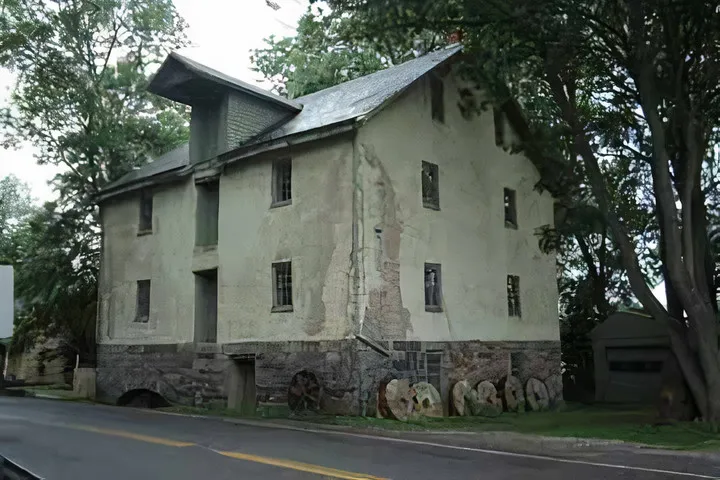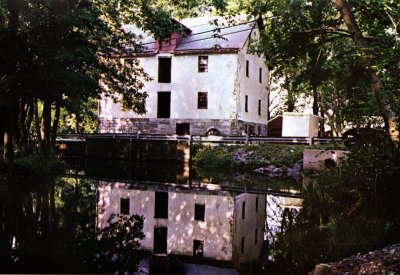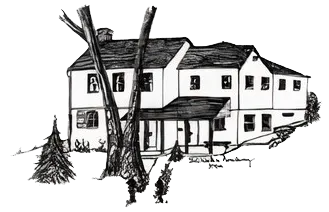excerpts from:
County Chronicles
GRIST MILLS
by Frank Dale
July, 2001 Book #14
The beautiful stone grist mill now nearly in the center of Stillwater Village on the Paulinskill River has ancient beginnings in the area.

Casper Shafer, a German immigrant, arrived in the new world in 1738, as a young man, and settled in the Stillwater area, then part of Hardwick, in 1741. By 1743 he had built a simple wooden grist mill on the Paulinskill River about a half mile up river from the present structure. This mill had a capacity of about 5 bushels of corn a day, nothing to be ashamed of in 1742. As the only mill in the area, business was good, so good that Shafer, in 1764, built a larger mill to replace his first one, this one, located slightly down river on the main street of the village of Stiliwater, at the site of the present mill.
Some of the flour produced at the new mill, prior to the Revolutionary War, was shipped by flatboats, during the high water season, down the Paulinskill to the Delaware and, then, down the Delaware to Philadelphia. Shafer’s boats didn’t return from Philadelphia empty, of course, but carried back with them a variety of foods and manufactured goods that businessman Shafer resold from a store he established in Stillwater. In 1774, Shafer added a saw mill to his grist mill operation and, just two years after that, he rebuilt the entire grist mill for a more up-to-date and efficient operation.
Caspar didn’t reside long in the miller’s cottage but, rather, moved into a small wooden residence which he promptly expanded into a stone mansion. And this fine estate had living quarters in the original wooden house for his small group of slaves. This fine home still stands in the village overlooking, from nearby high ground, the family mill.
In 1775, German immigrant Shafer was also politically active, in his new homeland on the verge of revolution. He served on the Sussex County Committee of Safety, an organization that was advocating independence from Britain a full year before independence was declared and the new nation came into being. German-American Shafer felt no love for Britain but he was too old to serve as a soldier in the Revolutionary army. However, he had one son, Abraham, who marched with other volunteers to Morristown in the brutal winter of 1777 in the response to Washington’s call for help. His other sons, Peter and Isaac, served in the local militia.
This strong anti-British feeling apparently did not apply to the troops of British ally, the German-Hessian soldiers. Thousands of these German soldiers were captured in the great military victory at Saratoga, New York, and were marched southward to a prisoner-of-war stockade in Virginia. While this mass of German prisoners passed, afoot, through Sussex County, many escaped and, when discovered by local folk, instead of being returned to their military captors, were accepted by the dominant German-American population, of whom Caspar Shafer was a leader. They were given jobs on local farms and mills and some married local frauleins. Most became loyal and hard-working American, and Sussex County, citizens.
Caspar Shafer’s very profitable milling business lasted almost four decades and, although the Revolutionary War caused a temporary decline, business picked up again after the war. Two of Caspar’s sons, Abraham and Isaac, worked hard at their father’s mill and took it over after their father’s death in 1784, at age 71. However, the third son, Peter, shortly after the war ended, constructed his own grist mill and river dam on the Paulinskill just five miles downstream from Stillwater. This mill was a large 3 story wooden structure with a ten foot man-made waterfall, an extremely potent power source. But this dam across the river here put an end to the Stillwater Mill’s use of this river to carry goods to the Delaware River and thence to Philadelphia. Little is known of Peter’s mill except that it wasn’t a big success. Peter later sold his mill to A. J. Hill.
After the Revolutionary War, Casper, and other family members who followed him, knew only success in the milling business. After his death, his sons and his grandsons, took over the business and continued the family’s prosperity. Casper’s son, Nathan Shafer, built a home he called ‘Whitehall’ in Stillwater near his father’s lovely home, and on a par with it. By 1816, a grandson, Abram, was supervising the milling operation with the aid of his two sons, Nathan and Peter B. and they hired an experienced and competent miller by the name of James Beatty, as well. The mill was operated capably. This father-and-sons team, in addition, built and operated a tannery, a blacksmith shop, a linseed oil mill, and a distillery, all in the Shafers’ home town. Much of the manual labor involved in these undertakings was performed by a dozen family-owned slaves. It was a busy and prosperous village and the Shafer dominance continued. A map of the small village, shows the village with 25 houses, ten of which were owned and lived in by Shafers, and, of course, this didn’t include Shafer women who, through marriage, gave up the family name. But this same map, dated for a somewhat later period, 1860, indicates that, by this time, several of the Shafer men in town were not in the milling business, but, rather, were wheelwrights, and blacksmiths, … and one, a shoemaker.

The new mill that was erected by Shafer in 1776 served the family until 1840 when, after more than 60 years in operation, it was destroyed by fire. The replacement mill was built in the same location, the job completed in 1844, using many of the original stones, but otherwise using the most modem equipment available, such as conveyors and turbines. This mill has survived up to the present time and is still visible and impressive.
The milling operation remained in the control of the Shafer family until 1861, for almost 120 years, an unusually long time for single-family’s ownership, but family interest started to decline ten years before this. And, although several good citizens named Shafer remained, and still remain, in the area, they went into other activities. Maybe they sensed the failing future in local grist milling and decided to get Out early.
However, the milling operation continued, without the Shafer family, through the rest of the century but then began to decline, due to the growing western competition. The names of the new owners did not attract the attention that the Shafers had and many identifications have been lost. One of the outstanding names for this area, Hendershott, appears as one of the mill owners after the Shafers as did A.D. Connell and, strangely enough, a local physician, Dr. Moore.
The most unique owner of this period was a female of the species, Mrs. Jane McCord. She and her husband, Joseph, had owned and operated the mill from 1926 but, early in his ownership, Joseph, a former college professor at Columbia University, was injured, fatally, while working at his mill. His body was discovered in the mill’s pit by neighbor, Leon A. Roof, whose son, Gus, would grow up to be a grist mill champion. Widow Jane then supervised the mill operation for many years with the help of hired millers, Harry Tracy was one. She finally ceased the operation, after almost thirty years, in October of 1954. The mill then was closed down, not unusual for this period, but it didn’t stay closed.
In 1972, local farmer Willard Klemm bought the mill and 15 acres, and shortly, Klernm took in as a partner, another local farmer, Gus Roof, Leon Roofs son. Gus Roof was a master craftsman who did much of the wood restoration at the old mill. The two men totally repaired the long-idle structure and its deteriorated and leaking mill dam. The old turbine was started again and water power did the work. The 250 year-old mill house was occupied once more and the mill itself functioned exactly as it had when it was reconstructed in 1844. Both of the local farmers owned hundreds of additional acres in the area and their large grain crops were ground in this reborn mill. This new generation of millers, in addition to growing and grinding grain, opened the mill every weekend to the general public. They handed out a brochure to visitors subtitled “Fun For the Whole Family” which listed guided tours of the mill, picnic grounds, hay rides, nature walks, fishing, and horses for kids to ride, around the mill property. Local schools brought classes of children here on their field trips, and Roof and Klemm offered a grist mill education to interested visitors, a generation who never before witnessed a mill in operation. The operating mill and the educational program lasted almost a decade, but wasn’t a money-maker for the young farmers. Eventually, they sold the property to a new owner, Richard Buxton. Buxton was a local restaurateur who bought the mill to put his two sons to work .. .but they had other ideas. The mill then sat empty and unused during the nearly quarter-century of Buxton ownership, and it deteriorated.
Gus Roof, however, established a reputation through his Stillwater work, and has been kept busy in the area restoring neglected mills; his outstanding accomplishment, after Stillwater, has been the Waterloo Mill, the Blairstown Mill and even some mills Out of state. And he now gets valuable assistance of his son, George and his good friend, Art Satter.
The Stillwater Mill sits empty and idle today but is hard to ignore, located at the Main Street crossing of the Paulinskill River in still-rural Stillwater. The mill house, however, has been spruced up and is presently rented out, this income used for mill repairs and restoration. The stone mansion that was the Caspar Shaffer homestead overlooking the mill is now the home of mill savior, Gus Roof, and his equally involved and competent wife, Elsie. The State of New Jersey has purchased the mill and apparently plans to restore the structure…with the help and drive of several groups including the Ridge and Valley Organization, local historical groups, and concerned local folks of all kinds. It would be one of the better things the government could do with taxpayer’s money. This historic structure cannot be allowed to deteriorate.
